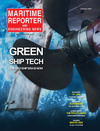
Page 43: of Maritime Reporter Magazine (February 2020)
Green Ship Technology
Read this page in Pdf, Flash or Html5 edition of February 2020 Maritime Reporter Magazine
Source: Kawasaki Kisen Kaisha, Ltd.
The “K” Line Fleet (As of 9/30/20)
Type of Vessel No. DWT(MT)
Dry Bulk Carriers 195 25,339,430
Thermal Coal Carriers 29 2,580,614
LNG Carriers 47 3,953,514
Oil Tankers 17 2,546,549
Offshore Support Vessels 6 29,186
Drillship 1 -
FPSO 1 -
Car Carriers 84 1,384,734
Short Sea and Coastal ships 52 604,581
Containerships 46 4,082,343
Total 478 40,520,951 * The number of owned vessels includes co-owned vessels, and deadweight tonnage includes share of other companies’ ownership in co-owned vessels.
* Includes ? agships and spot and/or short-term activities at the end of term.
We expect that LNG fuel have potential used widely fu- ture and now considering the use for various types of ships.
Also, we think that development of LNG bunkering infra- structure will redound to miniaturizing fuel tank, and LNG fuel will be fascinating for not only environmental aspect but also economical aspect.
Looking beyond fuel, can you describe the technology(s) onboard your vessels that you have found to provide good results.
We understand the goal of cutting GHG total volume by 50% is an ambitious target that needs 90 to 100% of improvement effectively. To have the results, we think it is necessary to utilize reproducible energy such as wind, wave, solar light on top of Zero Emission technology like fuel conversion. We also believe it is necessary to have changes in logis- tics in the long term. Maritime transport is already an envi- ronmentally friendly option and we can have a bigger GHG reduction impact if we combine ship size enlargement and slower navigation. However, we need to make sure to obtain
MR #2 (34-49).indd 43 2/5/2020 11:57:59 AM

 42
42

 44
44
